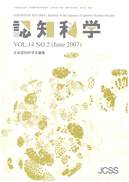巻号一覧

14 巻 (2007)
- 4 号 p. 467-
- 3 号 p. 231-
- 2 号 p. 171-
- 1 号 p. 1-
前身誌
14 巻, 2 号
選択された号の論文の6件中1~6を表示しています
- |<
- <
- 1
- >
- >|
巻頭言
-
伊藤 毅志2007 年14 巻2 号 p. 171-172
発行日: 2007年
公開日: 2009/03/06
ジャーナル フリーPDF形式でダウンロード (514K)
研究論文
-
Jun-Ichi Tanaka, Katsuo Tamaoka, Hiromu Sakai2007 年14 巻2 号 p. 173-191
発行日: 2007年
公開日: 2009/03/06
ジャーナル フリーThe present study conducted two experiments to examine the effects of syntactic priming in sentence comprehension, using a cross-modal priming task which required participants to make acceptability judgment of Japanese sentences with canonical and scrambled word orders. Experiment 1 investigated whether or not the speed of target sentence processing would be affected by the syntactic structure of prime sentences. Prime sentences matching target sentences in word order facilitated processing of target sentences even though prime-target pairs shared no content words, while prime-target pairs with mismatched word orders demonstrated weak facilitation effects. Experiment 2 examined the processing speed of target sentences primed by a sequence of nouns without any syntactic structure. The weak priming effects disappeared in the noun prime condition, which suggested that those observed in the mismatch condition in Experiment 1 were due to partial overlap of the syntactic structure. The overall results showed that the priming effects observed in these experiments were syntactic in nature and independent of lexical⁄semantic priming.抄録全体を表示PDF形式でダウンロード (1130K) -
井藤 寛志, 齋藤 洋典, 白石 知子, 山本 裕二2007 年14 巻2 号 p. 192-205
発行日: 2007年
公開日: 2009/03/06
ジャーナル フリーIn order to learn novel actions, it is essential to observe and imitate similar actions performed by other individuals. Two experiments were conducted to investigate whether the participants bound together five meaningless postures during observation. The participants were divided into three groups according to the experimental conditions: the observation of postures, the imitation of postures, and the imitation of postures including the arm movements between subsequent postures, respectively. The participants' task was to memorize five sequentially-presented meaningless postures, after which the participants were either to recall the subsequent posture neighboring the one presented (Experiment 1), or to recognize and recall the same postures (Experiment 2). The participants were asked to discern the strategy judgments (visual or verbal encoding) they used for each trial. A number of joints functioning in the changes in the neighboring postures (1- and 4-step conditions) were manipulated. The results of Experiment 1 and 2 indicated that the correct recall rates (the binding effect) under the 1-step condition were higher than the 4-step condition in the imitation and the movement imitation groups, but that the binding effect was not to be found in the observation group. However, in both Experiment 1 and 2, binding effects were found in the correct recall rates in all three groups based on the visual encoding when the verbal encoding had been eliminated. The results suggest that observation elicits the binding between neighboring meaningless postures regardless of the imitation of body movement.抄録全体を表示PDF形式でダウンロード (2379K) -
田中 吉史2007 年14 巻2 号 p. 206-216
発行日: 2007年
公開日: 2009/03/06
ジャーナル フリーWe investigated the effect of existing words on the generation of non-words. Native Japanese speaking college students (n = 103) generated 2702 non-words consisting of two to ten Hiragana letters during five minutes. The generated non-words resembled existing, familiar, Japanese words in terms of letter frequencies and of bigrams (two adjacent letters in a word). The non-words were also constrained by a phonological rule (*DD-constraint; Ito & Mester, 1996) of the Japanese lexicon, which implies that the non-words were related to existing words. and could be included in the extreme periphery of the Japanese lexicon. Further analysis indicated that the selection of letters in the generated non-words was biased. The participants tended to repeatedly use the same letters, and moreover, frequencies of letters in non-words were more redundant than those in existing words and random combination of letters. These results suggest that the generated non-words were influenced by existing words, but also constrained by characteristics of the process of retrieving letters from memory.抄録全体を表示PDF形式でダウンロード (790K)
文献紹介
-
川合 伸幸2007 年14 巻2 号 p. 217-222
発行日: 2007年
公開日: 2009/03/06
ジャーナル フリー認知科学において「熟達化」は重要な研究テーマの1つである.芸術家,スポーツ選手,科学者など,各分野のエキスパートがその研究対象となることが少なくないが,普通の人が何気なく行っている熟達化もある.その1つが,顔の認識である.一般的な成人は,画像処理によってわずかに顔のパーツの距離(両眼間の距離や,眼と口の距離)が変えられただけでも,元の顔と違いを区別できる.しかし,他人種の顔写真を用いたときにはその成績が下がることや,子どもはそもそも成績が悪いことなどから,これは熟達化の1つであると考えられている.
成人の顔を見分ける能力は,他の種の顔にもほとんど般化しない.実際,私はチンパンジーならどの顔も区別がつくが,同じ類人猿のゴリラやオランウータンの顔は区別できない.本稿では,このような顔認識の熟達化が経験によってどのように変化するかを示した3編の実験論文を紹介する.
最初の論文は,音声知覚の発達と同様に,生後6ヶ月ではヒトとサルの両方の顔を個別に区別できるが,生後9ヶ月になると同種の顔しか区別できなくなることを示している.2番目の論文は,同じ人種の顔は区別できるが他人種の顔は区別しにくいという他人種効果は5歳までに出現するが,6歳以降に養子として異なる人種の地域に移住すれば,その人種の顔のほうが区別しやすくなるという可塑性を示したものである.3番目の論文は,サルとヒトの顔に対する識別能力を8歳児と成人で比較し,すでに8歳でヒトの顔のわずかな配置の違いを識別できるようになっており,それ以降にさらに発達する顔認識の熟達化は,かならずしもその後の顔認識の経験とは関連していないことを示唆している.抄録全体を表示PDF形式でダウンロード (633K)
書評
-
梅田 聡2007 年14 巻2 号 p. 223-224
発行日: 2007年
公開日: 2009/03/06
ジャーナル フリーPDF形式でダウンロード (525K)
- |<
- <
- 1
- >
- >|